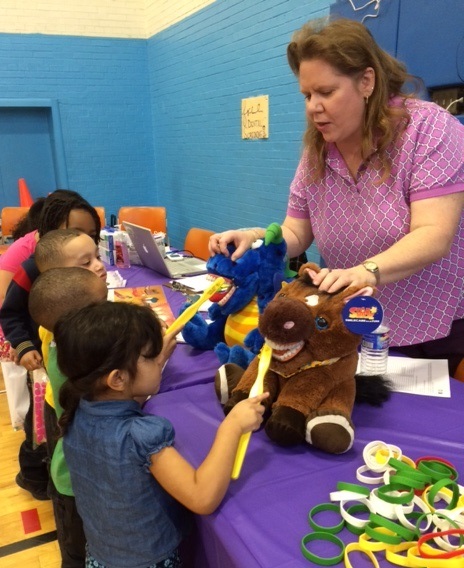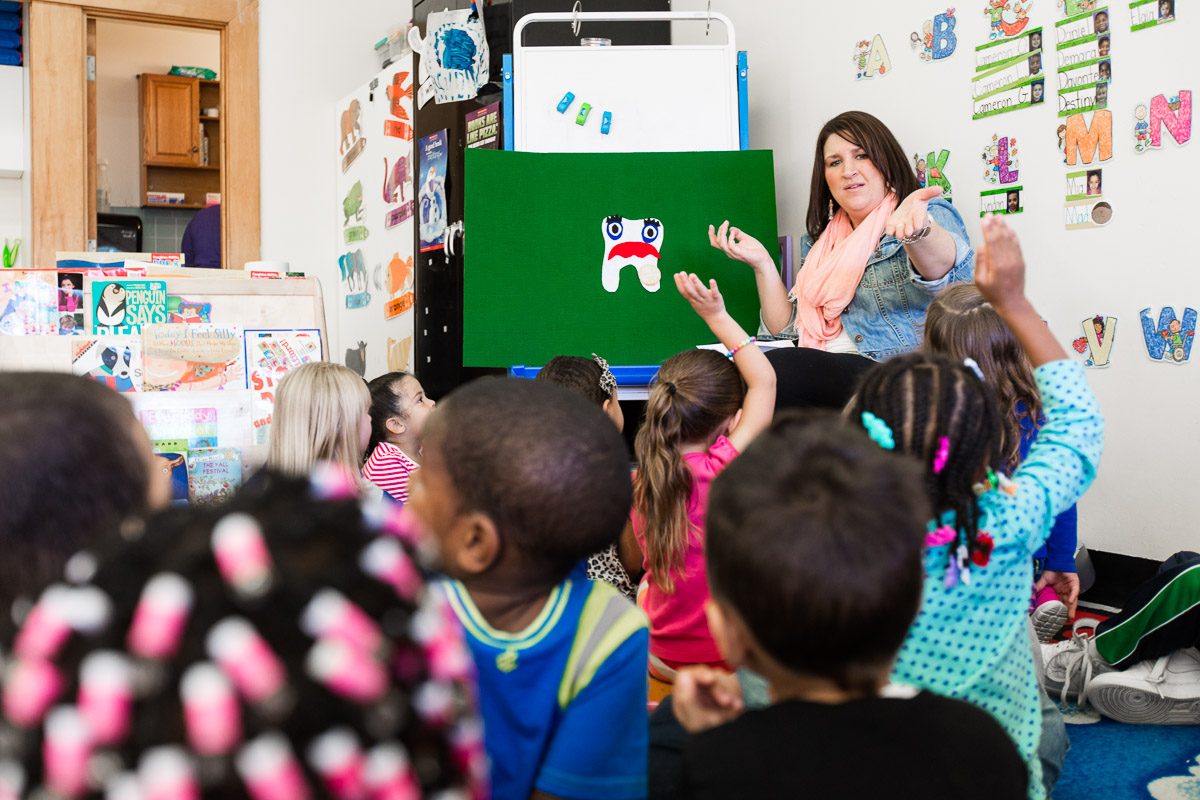While some preschoolers formed lines and patiently waited a turn, others excitedly ran from one oral health activity to the next, each child eager to blurt out a tooth-healthy food fact, participate in a lesson on brushing teeth, or sing and dance to “Happy Teeth Happy Smiles.” On an afternoon in March, the gymnasium at Holy Cross Head Start in Buffalo, NY, was filled with children, parents and community members all interested in learning more about dental health at the school’s annual Cavity Free Kids Health Fair.
The health fair is just one of many creative ways that Chris Tedesco, health coordinator at Holy Cross Head Start, is spreading the Cavity Free Kids curriculum in Western New York.
Cavity Free Kids is an oral health curriculum, developed by the Washington Dental Services Foundation, with a rich collection of lessons, activities, stories and songs that actively engages young children in play-based learning. The curriculum places an additional emphasis on practicing good oral health habits at home. 
As part of a two-year grant, Holy Cross Head Start is one of two regional hubs in western New York that will manage all Cavity Free Kids training across the region, with the purpose of spreading the program throughout the community. A Cavity Free Kids grantee partner since 2010, under this new hub model Tedesco is now overseeing operations for Erie, Niagara, Genesee and Orleans counties.
Like Holy Cross Head Start, Cattaraugus Wyoming County Project Head Start has been a Cavity Free Kids grantee partner since 2010. That’s where Theresa Wells, coordinator of health, disabilities and nutrition for Cattaraugus Wyoming County Project Head Start, is running the Health Foundation’s second regional hub, which covers Cattaraugus, Wyoming, Chautauqua and Allegany counties.
Throughout 2016 and 2017, both regional hubs are developing a cadre of master Cavity Free Kids trainers, setting up localized community-based hubs across their counties and supporting these hubs in their training and expansion operations. They are also building new partnerships while pushing into new geographies and new settings to expand the programs reach. By developing these two regional hubs, the Foundation’s goal is that Cavity Free Kids will be a sustainable model in the Western New York community by the end of 2017.
While Tedesco and Wells have different approaches for meeting that goal, both of their ideas for how to reach it are proving to be effective.
Tedesco has built a strong team of three to manage trainings and community events, and generate partnerships.
“The three of us complement each other very well. We have our own strengths which help us back each other up,” says Tedesco.
In their first year, together they have trained 11 new master trainers across Erie and Niagara counties. They now have new master trainers at Niagara Falls Memorial Medical Center, the Child and Adult Care Food Program and the Erie County Child Care Resource Network.
“We have recruited at community events and meetings that we attend. We are always willing to think outside the box and adapt the program to meet the interested agency’s needs,” said Tedesco. The “train the trainer” approach has allowed Tedesco to reach 91 staff members from community organizations who will also train and deliver the Cavity Free Kids curriculum.
Tedesco and her team have expanded their outreach efforts to include YWCAs, family day care centers, WIC and the Department of Social Services across all four counties in their territory. They have partnered with University at Buffalo Smile Team, the Summit Educational Center and set up health fair tables across the four counties to recruit more partners.
“Everyone loves going through the Cavity Free Kids kit with us and seeing how easy and flexible the curriculum is to use. They appreciate the free tooth brushes, and that the kit includes every day materials that are easy to replace,” says Tedesco.
Wells agrees that the partners she is forging relationships with are also very enthusiastic about the curriculum. “We offer activities and lessons from the kit to interested partners, and we do the introduction to the curriculum on-sight so that they can see how the kids interact with the curriculum and how excited they get,” says Wells.
She said they also pull out lessons from the curriculum to teach during training sessions as well.
“Anyone we work with is embracing the curriculum because they can pick and choose activities. The lessons fit in with their existing curriculum, so Cavity Free Kids is a way to re-energize what they are already teaching in the classroom, and it is cost effective and can easily be replicated in the future without a lot of cost,” says Wells.
Wells hired a community outreach specialist to assist in her expansion efforts across Cattaraugus, Wyoming, Chautauqua and Allegany counties. Known as the “tooth fairy” to many children across these four counties, LeAnn Hodge is taking an active role in the classroom by teaching lessons and bringing the interested partners on board.
“LeAnn is very creative and has been very successful in classroom implementation. She usually begins by getting everyone moving or providing a prop that peaks their interest. I often hear kids talking about the “sugar bug duds,” as she gets the children together at a table to brush their teeth and the kids become competitive in the activity,” says Wells.
As community outreach specialist, Hodge is increasingly talking to agencies outside of Head Start to spread the curriculum.
Wells and Hodge say they have received a lot of interest from WIC, health departments, in-home and private day care centers, SUNY Fredonia and its Child and Community Campus Center, as well as the YMCA. “The addition of LeAnn has allowed her to devote time to events and developing partnerships, which allows me to make sure the community hubs and trainers have all of the materials they need,” says Wells.
Today, every child enrolled in Head Start across western New York’s eight counties is now receiving Cavity Free Kids. During the past 18 months alone, more than 5,300 children have received the CFK curriculum, including more than 900 new children reached through private day care settings and more than 1,100 new children through community day settings.
As a result of the successes the western New York hubs achieved using this model, in late 2016 the Health Foundation granted funding to the Child Development Council in Cortland, NY to become the Cavity Free Kids regional hub for the central New York counties of Cortland, Tompkins, Onondaga, Madison, Herkimer and Oneida.
Anne Withers, program director for the Child Development Council, has been overseeing implementation as a local Cavity Free Kids hub since 2012 and is excited about leading the larger expansion efforts.
“There is such a great connection between how oral health connects with overall health, and most people don’t realize that. Getting kids to practice good oral health habits at such a young age becomes a lifelong healthy habit,” explains Withers.
In just a short time, Withers is quickly gaining traction across central New York. Cortland County’s “Cavity Free Cortland” initiative is a collaboration between the county, Head Start, Seven Valleys Health Coalition and other interested dental professionals, and Withers says Cavity Free Kids naturally fits with the initiative because dental health is such an important topic at this point in time. Withers is using three community hubs to train additional staff and deliver the curriculum, while acting as a resource by assisting the hubs with outreach and training efforts in their communities.
Like the two western New York hubs, Withers is expanding Cavity Free Kids beyond Head Start centers to reach other family day cares and community settings. She anticipates 1,395 new children will be participating in Cavity Free Kids by the end of the first year of the program.
Since the Health Foundation launched Cavity Free Kids in 2010, our partners have collectively trained teachers and staff in more than 100 early child care centers and organizations, reaching more than 23,000 young children in classroom settings. More than 10,000 children have also been exposed to the CFK curriculum through WIC and outreach at other community agencies.



